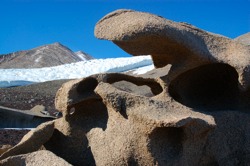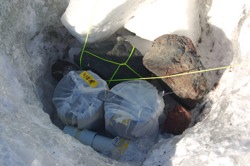GOLF 4-3-9 Antarctica Expedition 2008
Report Day 16 -- Tuesday 11 November 2008 -- Checking off the Rest of Our Taylor Valley Science Program
GOLF 4-3-9 Antarctica Expedition 2008 |
| Daily Reports 1 | 2 | 3 | 4 | 5 | 8 | 9 | 10 | 13 | 14 | 15 | 16 | 20 | 25 | 27 | 30 | 35 | 37 | 38 | 42 |

Today, our photos chronicle our last full day in Taylor Valley: We deployed a set of our experiments in an ephemeral stream in upper Taylor Valley just above Lake Bonnie, and we did an evening hike to one of Lauries’ sampling site from for a soil yeast project that she is currently writing up.
The goal in our ephemeral stream deployment is to explore what microbes dominate a setting that consists almost entirely of water and basalt, and that is frozen throughout most of the year. Our colleagues from the LTER tell us that this stream is running at most about two months per year. This type of setting is probably the closest analog we can find on earth for the polar regions of Mars that are currently the targets for our search of extraterrestrial life.

Flying was a bit of an adventure because the wind was very gusty and strong. Katabatic winds high up on the slopes and anabatic winds lower down in the valley (figure that; see "News and Issues" section on this web page). Flying is rough, but the real worry is the landing in gusty winds. Barry (our pilot) has been flying in the dry valleys for many years and he got us there (and back) safely, no worries. When we arrived at our spot, our target creek was still solidly frozen, without any melting runoff (too cold). We had to determine where it would flow the most once it starts melting so we could place our experiment such that it will be in liquid water during the melting season. This was remarkably hard once we started chipping away the ice. Where will the ice stick to the ground and where will water flow under the ice? Both of us have seen melting ice fields with a running stream underneath many times before but once you have to put down an experiment you find it very hard to predict where the stream is most likely to flow. In the end we decided to put the experiment in the lowermost icy part of the stream (currently a mass of ice) and hope for the best. There, we think, it is most likely to see water because all the water has to go through this spot. We will have a temperature recorder in this experiment that will tell us, at least in hindsight, whether and when the surrounding water was frozen or a liquid. Coming back to our Mars analog: This kind of thing will be really tough to do on Mars, with a remote spacecraft and lander.
We came back to camp in time to see Andrew making some Pizza for the whole gang. We contributed to the group effort by taking the ATV for a spin to the Commonwealth glacier to collect ice (=glacier berries) for our drinking water. It is amazing how much fun chores can be.
After dinner we went for a hike to Canada Glacier. Half of the trip was made by ATV on the lake ice. We can only use ATVs in the Dry Valleys on the lakes because of the fragile nature of the soil communities. We then hiked the remainder of the way to the Commonwealth glacier that is to the East of Lake Fryxell. This is some moonscape! When you walk around you cannot imagine ANY life out there, but Lima Charlie assured Hotel Sierra that there is lots of it and she actually found some thriving yeast populations on the slopes of the glacial melt pond. Laurie re-visited her sampling sites and took some more photographs for her files.
We noted that the ground seemed entirely undisturbed, despite the intense sampling the Yeasty Boyz did five years ago. So, contrary to common wisdom, not all traces of human activity are preserved in the Dry valleys. This speaks well of their "low impact" walking at the time and the success of their remediation efforts "cleaning up" sampling sites. However this success also makes it hard to exactly reproduce what one has done previously, even though Lima Charlie was pretty confident that she did indeed find the sites she has collected previously (The GPS coordinates are a big help too!)
Hiking back to the ATV was fun but the ride back to camp on the ice was just magical. It was close to midnight and we were riding into the sun, a bit tired, in soft but bright light coming from the sun and the brilliant but irregular icy lake surface. The picture of Canada Glacier gives a bit of that feeling. When we got back to camp everybody was asleep – they had a grueling day of deploying experiments and lots of lake water sampling ahead of them. They had to get up at 4 am to stay on schedule.
One more sunny night in Taylor Valley and then it is time to break up our tents and hope the helicopter comes to take us back to McMurdo. We completed what we came to do.
| GOLF 4-3-9 Antarctica Expedition |